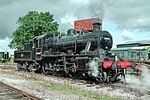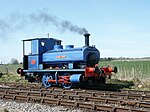East Somerset Railway
| East Somerset Railway | |
|---|---|
standard gauge | |
| Closed to passengers | 1963 |
| Closed | 1985 |
| Preservation history | |
| 1972 | Restoration (of the ESR) begins |
| 1974 | ESR Granted Light Railway Order |
| 1975 | ESR re-opened |
| 1981 | ESR extended to Merryfield halt |
| 1985 | ESR extended into Mendip Vale |
| Headquarters | Cranmore |
East Somerset Railway | |||||||||||||||||||||||||||||||||||||||||||||||||||||||||||||||||||||||||||||||||||||||||||||||||||||||||||||||||||||||||||||||||||||||
|---|---|---|---|---|---|---|---|---|---|---|---|---|---|---|---|---|---|---|---|---|---|---|---|---|---|---|---|---|---|---|---|---|---|---|---|---|---|---|---|---|---|---|---|---|---|---|---|---|---|---|---|---|---|---|---|---|---|---|---|---|---|---|---|---|---|---|---|---|---|---|---|---|---|---|---|---|---|---|---|---|---|---|---|---|---|---|---|---|---|---|---|---|---|---|---|---|---|---|---|---|---|---|---|---|---|---|---|---|---|---|---|---|---|---|---|---|---|---|---|---|---|---|---|---|---|---|---|---|---|---|---|---|---|---|---|
| |||||||||||||||||||||||||||||||||||||||||||||||||||||||||||||||||||||||||||||||||||||||||||||||||||||||||||||||||||||||||||||||||||||||
The East Somerset Railway is a 1 mi 63 ch (2.9 km) heritage railway in Somerset, running between Cranmore and Mendip Vale. The railway was once part of the former Cheddar Valley line that ran from Witham to Yatton, meeting the Somerset and Dorset Joint Railway at Wells but was considered for closure even before the publication of 'The Reshaping of British Railways' by Dr Richard Beeching in March 1963.
History
The East Somerset Railway Company was incorporated under the East Somerset Railway Act on 5 June 1856
Four years later the line was extended to
In 1878, the GWR joined the East Somerset line with the Cheddar Valley line to Wells, which had been built by the Bristol and Exeter Railway, by obtaining running rights over a section of the Somerset and Dorset Joint Railway and running its trains through the S&DJR Wells station at Priory Road, though GWR trains did not stop at Priory Road until 1934. At this stage, the main traffic became the through trains from Yatton to Witham and the East Somerset Railway station in Wells closed, with Wells (Tucker Street) becoming the station for the city on the line. The Yatton to Witham service remained in use with the GWR and later BR until passenger service finally ceased on 7 September 1963, however trains carrying bitumen continued until 1985.
Preservation
In 1971/72, the artist
The East Somerset Railway only operates the line between
In 1991, a new station building was constructed at Cranmore which now includes a cafe, booking office, gift shop and toilets. The platform then extends to the old station which is now a museum. On the platform is an old K4
Cranmore Traincare and Maintenance and Services (CTMS) was set up in 1995 at the Cranmore base of the ESR. They carry out professional repairs to carriages and bodywork overhauls on Diesel Locomotives. CTMS is based opposite the ESR loco workshop in a separate preservation era shed.
An order by the Secretary of State for Transport in 2005 allowed a further 660 yards (600 metres) of track to be used.[8]
On 25 March 2007, the East Somerset Railway announced that it had received a £7,500 grant from Shepton 21 Group, a local organisation, set up to regenerate the area around Shepton Mallet. The money was to be spent on conducting a feasibility study into extending the line towards Shepton Mallet, with a possible new terminus at
Locomotives
Operational steam locomotives
| Number & name | Type | Wheels | Built | To ESR | Notes | Image |
|---|---|---|---|---|---|---|
| 46447 | LMS Ivatt Class 2 | 2-6-0 | 1950 | 2012 | One of 128 similar locomotives, 46447 was built by British Railways at London Midland and Scottish Railway (LMS) design. Its first allocation was to Crewe North shed. After withdrawal in 1966, it was sold for scrap to the Woodham Brothers but was sold by them for preservation in 1972. Some restoration was done at the Buckinghamshire Railway Centre and the Isle of Wight Steam Railway but this was completed at Cranmore and it worked its first train on 26 October 2014.[10]
|

|
| 4110 | GWR 5101 | T
|
1936 | 2020 | 4110 was built in 1936 at Barry in 1979 by the Great Western Preservation Group and moved to Southall Railway Centre. It later moved to Tyseley Locomotive Works then the West Somerset Railway for restoration but this was not completed.[citation needed] The locomotive was purchased by the Dartmouth Steam Railway in 2019 and arrived at Cranmore on 10 January 2020. Once restoration is completed it will run at the East Somerset Railway for three years.[11]
|

|
| Lady Nan | Andrew Barclay Sons & Co. | ST
|
1920 | 1975 | This locomotive was built by Andrew Barclay in 1920 and given their works number 1719. It worked for several owners and was known at different times as 'Hurlford Fireclay Works No. 2' and 'Glenfield No. 2'. It was sold for scrap in 1972 but was instead preserved, reaching the East Somerset Railway on 5 November 1975. It was named Lady Nan after one of its owners in 1985. It was loaned to the National Railway Museum for a while but returned to Cranmore in 2000. It is painted in a blue livery.[10] | 
|
Former resident locomotives include 56xx 5637, 9F 92203 "Black Prince", Standard 4MT 4-6-0 75029 The Green Knight, Standard 4MT 2-6-0 76017, GWR Castle 5029 Nunney Castle, SR Westcountry 34027 'Taw Valley', SR West Country 34105 Swanage, SR S15 828, GWR Manor 7822 Foxcote Manor, GWR 14xx 1450, LBSCR E1 110, LMS 3F 47493, NER J72 69023 'Joem' and GNR J52 68846.[citation needed]
Steam locomotives under overhaul
| Number & name | Class | Wheel arrangement | Built | To ESR | Notes | Image |
|---|---|---|---|---|---|---|
| 31 Meteor | RSH | T
|
1950 | ? | Number 31 was built in 1950. It worked for the National Coal Board at Whittle Colliery throughout its working life before being withdrawn. It was originally sold to the North Yorkshire Moors Railway before being sold to the Avon Valley Railway. It is now at Merryfield Lane on the ESR in a stripped down state. It requires a new firebox.[citation needed] | |
| 4247 | GWR 5205 | T
|
1916 | 2021 | Built at Swindon as a 4200 in 1916, but converted to 5205 specification with outside steam pipes but maintaining the straight footplate. It left the Barry Scrapyard in April 1985. It is at Cranmore for restoration before moving to the Dartmouth Steam Railway on loan from its owners the 4247 Preservation Society.[citation needed] | 
|
In recent years, the ESR workshops have restored several locomotives belonging to other railways such as LMS Ivatt Class 2 2-6-2T 41313 in 2017 and fellow Ivatt 46447 in 2014 for the Isle of Wight Steam Railway. GWR 5205 Class 5239 Goliath was completed for the Dartmouth Steam Railway in November 2019.[citation needed]
Diesel traction
The ESR is host to a Class 108 DMU as well as a fleet of Sentinel shunting locomotives, these are listed below:
| Number & name | Type | Built | To ESR | Notes | Image |
|---|---|---|---|---|---|
| L231 (51909 & 56271) | Class 108 | 1960 | 2013 | A two-car diesel multiple unit, it was withdrawn in 1993 and put into stirage before moving to Midsomer Norton in 2011 and then moving to Cranmore two years later and has been restored in British Rail blue livery. Car 51909 is a Driving Motor Brake Second; 56271 is a Driving Trailer Composite Lavatory. It is owned by The Mendip Traction & Rolling Stock Group.[12] | 
|
| DH16 | DH
CD Sentinel |
1964 | 2015 | Built for the Manchester Ship Canal in 1964 (works number 10175), later working at the Bowaters Paper Mill in Ellesmere Port. It was donated to the East Lancashire Railway in 1981. It was sold in 1999 and moved to Merehead for restoration in Manchester Ship Canal livery before finding a home on the West Somerset Railway where it was based from 2001 until 2015. Owned by the Sentinel Diesel Preservation Group (SDPG).[13] | 
|
| 39 | DH SR Sentinel |
1965 | 1999 | Built in 1965, works number 10218 operated for the Port of Bristol Authority (PBA) as their number 39. It was preserved on the Dean Forest Railway in 1984 and arrived at Cranmore in 1999. It is privately owned and painted in PBA Oxford blue livery.[13] | 
|
| 42 Eric | DH SR Sentinel |
1965 | 2007 | Built in 1965, works number 10221 operated for the Port of Bristol Authority as their number 42. It was redundant in 1983 and later worked at the Rover car factory at Longbridge in Birmingham, and for Blue Circle Cement in Westbury, Wiltshire where it was given the name Eric and later donated to the SDPG to be restored for preservation.[13] | 
|
| 199 | DH CD Sentinel |
1964 | 2007 | Built for | 
|
| Joan | DH SR Sentinel |
1963 | 2005 | Built by Rolls-Royce (works number 10165) as a demonstration locomotive in 1963, it was sold to the Oxfordshire Ironstone Company in 1964 and given the name Jane from the steam locomotive it replaced. It later worked for Stewarts & LLoyds and the British Steel Corporation. It was withdrawn in 1989 and initially preserved on the Dean Forest Railway. It arrived at Cranmore in 2005 for restoration which was completed in 2017 and once again carries the Oxfordshire Ironstone Company's maroon livery. Owned by the SDPG.[13] | 
|
Features
The distance from Cranmore to Mendip Vale is 1 mile 63 chains (2.9 km).[15]


| Point | Coordinates (links to map & photo sources) |
Notes |
|---|---|---|
| Cranmore railway station | 51°11′06″N 2°28′41″W / 51.185°N 2.478°W | Eastern start of railway line |
| Cranmore West railway station | 51°11′02″N 2°28′59″W / 51.184°N 2.483°W | |
| Merryfield Lane railway station | 51°10′52″N 2°29′53″W / 51.181°N 2.498°W | |
| Mendip Vale railway station | 51°10′48″N 2°31′12″W / 51.180°N 2.520°W | Western terminus |
References
- ^ "Railway Magazine", July 1958
- ^ "East Somerset Railway Company". The National Archives. Retrieved 26 August 2016.
- Wells Journal. 13 November 1858. Retrieved 26 August 2016 – via British Newspaper Archive.
- ^ Kelly's Directory of Somersetshire: With the City of Bristol. Kelly's Directory. 1883. p. 302. Retrieved 26 August 2016.
- ^ "History". East Somerset Railway. East Somerset Railway. Archived from the original on 12 June 2008. Retrieved 8 July 2008.
- ^ "Doulting Railway Cutting" (PDF). SSSI citation sheet. English Nature. Retrieved 8 July 2008.
- ^ "Cranmore Station". East Somerset Railway. Archived from the original on 21 July 2010. Retrieved 8 July 2008.
- ^ "The East Somerset Railway Order". Department of Transport. Archived from the original on 3 March 2010. Retrieved 30 September 2010.
- ^ "Press Release". East Somerset Railway. Retrieved 8 July 2008.
- ^ a b "Steam". East Somerset Railway. Retrieved 15 January 2023.
- ^ Duggan, Jamie (10 January 2020). "Steam locomotive 4110 arrives at the East Somerset Railway for restoration". RailAdvent. Retrieved 11 January 2020.
- ^ "Heritage Diesel Multiple Unit". eastsomersetrailway.com. Retrieved 24 August 2021.
- ^ a b c d e "Industrial Diesel Locomotives". eastsomersetrailway.com. Retrieved 24 August 2021.
- ^ "10199 at cranmore on 12-05-2022". Retrieved 22 February 2023.
- ISBN 0-9549866-1-X.
Further reading
- Phillips, Derek (2001). Steaming through the Cheddar Valley. Oxford Publishing Co. ISBN 0-86093-551-5.

